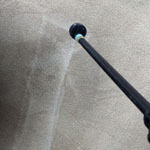
Carpets endure daily wear and tear, accumulating dirt, dust, and stains over time. Some stains, however, are more challenging than others – especially compound stains. These stains consist of multiple substances, making them harder to remove than single-substance stains. If left untreated, they can penetrate deep into carpet fibers, causing discoloration and damage. In this article, we’ll explore effective methods for cleaning very dirty carpets and tackling stubborn compound stains.
This post has been inspired by our recent carpet cleaning service in the Wallasey, Wirral area, where we successfully removed tough compound stains from a heavily soiled carpet.
Understanding Compound Stains
A compound stain is a combination of different types of stains, such as oil-based, protein-based, and dye-based substances. Common examples include food spills containing grease and artificial coloring, muddy footprints mixed with organic matter, and beverage stains with sugar and tannins. Because these stains contain multiple elements, they require a specialized cleaning approach.
Step-by-Step Compound Stain Removal
1. Pre-Inspection and Preparation
Before cleaning, it’s essential to assess the carpet’s condition and the severity of the stains. Identify the type of fibers in your carpet, as this will determine the appropriate cleaning solution. Gather the necessary tools, including a vacuum, stain remover, carpet cleaning machine, and microfiber cloths.
2. Dry Soil Removal
Vacuuming is the first step to eliminate loose dirt, dust, and debris. This prevents dry particles from turning into muddy residues when moisture is applied. A high-powered vacuum with strong suction can lift embedded dirt effectively.
3. Pre-Treatment of Stains
For compound stains, apply a targeted pre-treatment solution. A professional-grade carpet pre-spray with enzymatic cleaners can break down protein-based components, while a solvent-based solution helps dissolve greasy residues. Allow the treatment to dwell for at least 10–15 minutes to loosen the stain.
4. Deep Cleaning with Hot Water Extraction
Hot water extraction (steam cleaning) is one of the most effective methods for deep carpet cleaning. The process involves injecting hot water and a cleaning solution into the carpet fibers, followed by powerful extraction to remove dirt, bacteria, and stains. This method is highly effective for compound stains as it flushes out multiple stain elements simultaneously.
5. Spot Treatment and Agitation
Some stains may require additional spot treatment. Gently agitate the affected area using a soft-bristle brush to work the cleaner deeper into the fibers. Avoid aggressive scrubbing, as this can damage the carpet pile.
6. Rinsing and Drying
After deep cleaning, thoroughly rinse the carpet to remove any residual cleaning agents. Proper drying is crucial to prevent mold and mildew growth. Use high-speed air movers or open windows to accelerate the drying process.
Professional Carpet Cleaning Services
While DIY methods can help with minor stains, professional carpet cleaning ensures a more thorough and long-lasting result especially for Compound Stain Removal. At CarpetProCleaning, we specialize in removing stubborn compound stains using advanced cleaning techniques and industry-approved solutions. Whether your carpet is heavily soiled or has deep-seated stains, our expert team can restore its original appearance.
Final Thoughts
Dealing with a very dirty carpet and compound stains requires patience, expertise, and the right cleaning techniques. By following a systematic approach, you can effectively lift tough stains and refresh your carpets. If you need professional assistance, CarpetProCleaning is here to help. Call me today for free no obligation quote or advice. 07 574 923082 – Henryk. or check Our online instant quote.
See Compound Stain Removal video below:

